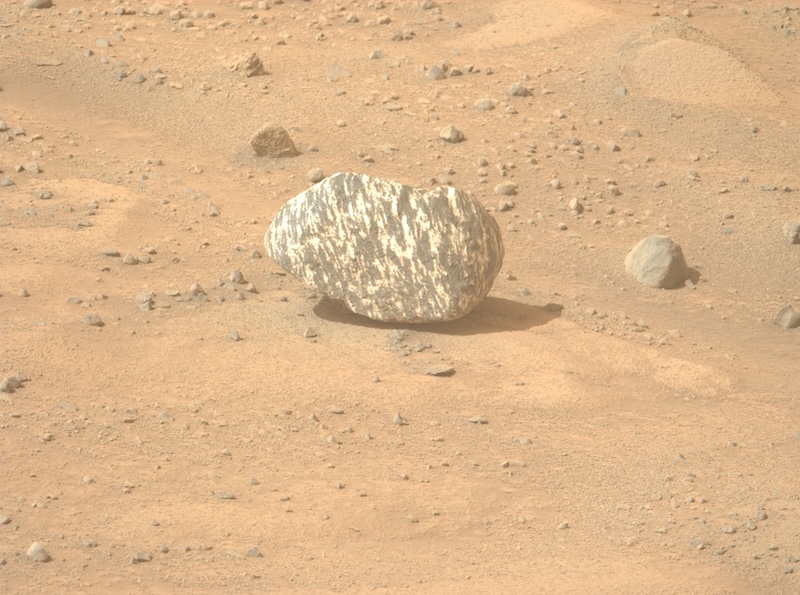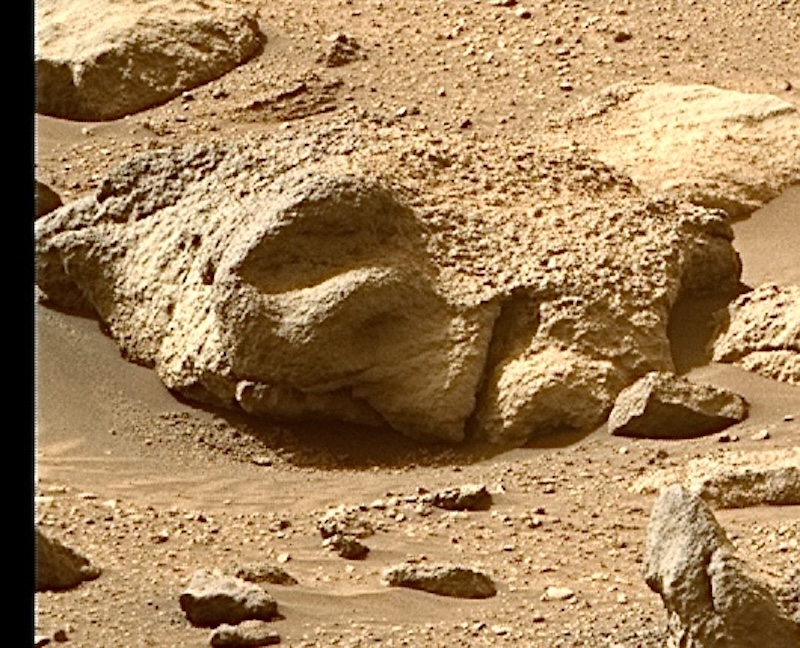- The “zebra rock” is the latest of the unusual rocks on Mars, found by NASA’s Perseverance rover. The rock has distinct dark and light stripes similar to those on zebras. It is all by itself, with no similar rocks nearby.
- Scientists said the zebra rock might be volcanic in origin, formed from magma or by other processes involving heat and pressure below the surface. It may have rolled down the crater rim to its current location.
- Perseverance also discovered a new Mars “face”. It’s a rock formation that looks like a face lying on its side.
More exciting news! EarthSky has received a $50,000 gift, with a request that it be used to collect matching funds. It’s time to make good on our obligation to match. Click here to donate to EarthSky!
‘Zebra rock’ on Mars surprises scientists
A couple weeks ago, NASA’s Perseverance rover came across an interesting rock. It was reminiscent of the coat of a zebra, with alternating black-and-white stripes. None of the rovers or previous landers had seen a rock quite like it before. Also, it was sitting all by itself, with no other similar rocks in the vicinity. How did it form, and how did it get there? NASA discussed the intriguing discovery in a new update on September 23, 2024.
Perseverance was traveling along a relatively flat stretch of pebbly terrain as it was beginning its ascent up the rim of Jezero crater. And that’s when it spotted the “zebra rock.” Even from a distance it looked unusual in the lower-resolution Navcam cameras. The mission team nicknamed it Freya Castle.
The rover moved closer and used its Mastcam-Z camera to get a better look. The black-and-white stripes were then easier to see. The rock itself was basically oval-shaped and about 1/2 foot, or 20 cm, long.

What is it?
Of course, as soon as the images were released, people began speculating about the striped rock. What was it? How did it get there? As NASA noted:
The internet immediately lit up with speculation about what this “zebra rock” might be, and we’ve enjoyed reading your theories!
The rover only did some general observations of the rock before it had to move on. But it did find some intriguing hints. The science team thinks that igneous and/or metamorphic processes likely formed the rock. Indeed, other speculation suggested it might be a gneiss, a type of metamorphic rock with similar kinds of stripes. Igneous rocks form when molten rock, magma or lava, cools and then solidifies. Metamorphic rocks form when heat, pressure or reactive fluids (such as hot, mineral-laden water) change existing rocks.
But why is Freya Castle all by itself? NASA said it likely originated from somewhere else and was somehow deposited at its current location. It may have rolled downhill from higher up on the crater rim. With that in mind, the science team is hoping that Perseverance may find more rocks like it as it continues to climb higher up the crater rim.

The new Mars face and other curious rocks
This is just the latest unusual rock that Perseverance has come across in its travels. Last July, the rover found a rock with weird leopard spots on it. The rock is in an old riverbed that cuts through the crater rim. Scientists said the spots might be related to ancient microbial life. Perseverance obtained samples of the rock that will one day be returned to Earth as part of the Mars Sample Return program for further study.
And just in the past few days, the rover also came across a rock that looks a lot like a person’s face lying sideways on the ground. It’s a case of pareidolia, that is, seeing a meaningful pattern or image that isn’t actually there … But it does get your attention!

Bottom line: NASA’s Perseverance rover has found an unusual striped “zebra rock” on Mars unlike any rocks seen before. How did it form and how did it get there?
Via NASA
Read more: Ancient life on Mars? Rover finds intriguing ‘leopard spots’
Read more: Perseverance rover explores Bright Angel in ancient riverbed